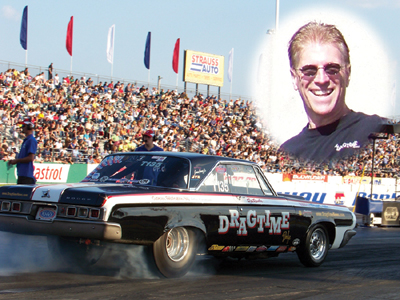| (Find
more More Bracket Racing 101 articles HERE)
 Everything
we do on the dragstrip relates to time. We put a time on
our windows, we try to leave on time, and we’ll hit
the brakes at the stripe to kill some time. Yet with all
of the importance of time to what we do, there are racers
who don’t fully understand the timing system of the
dragstrip. Everything
we do on the dragstrip relates to time. We put a time on
our windows, we try to leave on time, and we’ll hit
the brakes at the stripe to kill some time. Yet with all
of the importance of time to what we do, there are racers
who don’t fully understand the timing system of the
dragstrip.
In my
travels racing at Northeast dragstrips I’ve gotten
to know Al and Sue Smyth of Portatree Systems (www.PortaTree.com).
The Smyth family is extremely active in our sport. Al races
a stick SS/AH 1968 Barracuda, son Stephen races a 2009 A/SA
Hemi Challenger, and daughter Allison races a C/SA 1997
Firebird. Practice trees, full competitive drag racing timing
systems, and simulators are all part of the products that
Portatree manufactures. As someone who founded and runs
a company that makes timing systems for dragstrips, I thought
Al would be a great source of information. This issue we’ll
be focusing on the components we encounter at the starting
line, such as the pre-stage and stage beams, Autostart,
and Crosstalk. Next issue we’ll be looking at the
timing components down track.
You’ve
completed your burnout and are inching toward the starting
line. Unless you’re driving a top fuel car you don’t
need a person or ten to guide you into the beams: that’s
what the little bulbs are for. Let’s look at those
bulbs and the beams that trigger them. “A standard
drag race track start line consists of a Pre-stage, Stage,
and Guard beam,” said Al. “The guard beam is
the actual starting line and all down-track measurements
are made from this location. The Pre-stage and Stage beams
are 7 inches apart and the guard beam is typically 15 inches
out in front of the stage beam. The 60 foot clock is actually
61 feet 3 inches from the stage beam.”
Al
continues, “The main thing racers talk about regarding
the starting line is the rollout. When we set the rollout
at a facility, we first make sure that the beams are parallel
and square with respect to the 60 foot beams and the centerline
of the track. Once we know that the start line is square
then we set the rollout which is changed by raising or lowering
the beams. If you measure the height once the rollout has
been set, the beam is usually about 2 1/8 inches over the
track surface.”
Two
starting-line components that some racers are not clear
on are Autostart and Crosstalk. “Autostart consists
of four parts; Stage On time, Stage-to-Start time, variable
delay, and the Time Out setting. Stage On time tells the
computer that the vehicle is actually staged and is not
just a flickering bulb. Once the second car to stage meets
this condition the computer proceeds to the next cycle,
Stage-to-Start, which is the minimum time once the last
vehicle has staged. It is a fixed time set for each category
as different categories require different Autostart parameters.
Variable delay is the delay time after the Stage-to-Start
time has expired. The Time Out setting is the time the computer
will wait before starting the tree sequence whether the
last car is staged or not; in other words this setting occurs
when both drivers are pre-staged but only one is staged.
Once this condition is met, the time out period begins.”
Crosstalk
is another area that some don’t fully understand.
“Crosstalk was introduced when tracks began using
dividers and/or LED bulbs on the tree.” Until then,
racers with a crossover delay could watch their opponent’s
top bulb and react off that bulb. Dividers and LEDs changed
that because it was no longer possible to see the opponent’s
bulb. “With Crosstalk your top bulb comes on precisely
at the same time as your slower opponent’s top bulb
during a handicapped start.”
Next
time our focus will be the timing increments down track
to the finish line. Until then, thanks for reading and good
luck at the track.
|



